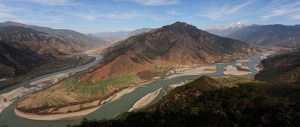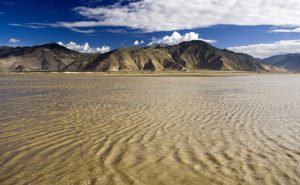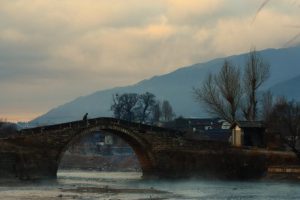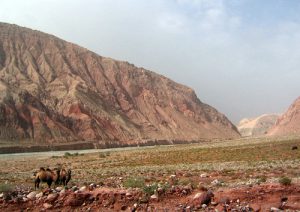Xia Jun is president of the International Water Resources Association and head of the Chinese Academy of Sciences’ Water Resources Centre. He spoke to Xu Nan and Zhang Chun in the run-up to World Water Week in Stockholm.
See China’s South-North water transfer is ‘irrational’
chinadialogue: Is it correct to say that China has plenty of water, but it’s unevenly distributed?
Xia Jun: Not necessarily plenty – we have a high global ranking on overall water resources, but on a per capita basis we’re much weaker. China has a large population, and while the economy has being doing well in recent years compared with the rest of the world, there are still lots of deeper issues.
China lies in the monsoon zone, and most of its precipitation comes during flood season – it is very unevenly distributed both geographically and over time. This leads to differences across regions, and you often have floods in the south while the north suffers drought. The north and north-east of China produce two-thirds of its grain, and those areas have huge plains and excellent light but lack water. The water and soil aren’t in the right places. And in some sense climate change is worsening these problems.
So China’s water issues are quite complex, and there are significant pressures.
cd: We’ve seen a lot of public debate over water transfer projects. What role and impacts do regional water transfers have? How should we evaluate all the projects getting under way?
See "China’s South-North water transfer is ‘irrational’"
XJ: Some of the national-level projects are extremely important for a developing nation.
Unlike many European countries, China’s rainfall is not equally distributed. China needs to figure out how to save the excess water of the flood season and use it in the dry season. In the recent droughts in the south-west, we saw just how lacking drinking water infrastructure is in some places. And even if the infrastructure catches up, there’s still a need to be able to transfer water during a drought.
So the ability to move water around is essential, to distribute the water more evenly. Of course you need to work in coordination, to balance the ecological impact. But you can’t store and transfer water without dams and reservoirs, can you? Lessons have been learned since the US started building dams in the 1960s, and the ecological impact is better understood. The question now is making environmental improvements and shifting attention from construction to overall coordination, to gain benefits from unified management.
cd: Hydropower development has taken off in China, particularly in the south-west. But there has been some controversy – for example the Three Gorges Dam has been successful in controlling floods downstream, but some claim it has exacerbated factors that cause drought, or even that it has redistributed tensions in the earth’s crust. How should we view the ecological and hydrological effects of large dams?
Xia: Do we want to go back to a primitive state of nature? Nobody does. As the old Chinese saying goes, you can’t expect a horse to gallop but not to graze. The overall aim of economic development is the right one, but there’s a need to minimise the ecological impact. We need more high and new technology, and extremely good planning.
China’s potential for hydropower development is among the highest in the world, and current exploitation rates are not high – much less than in the US, Russia or Brazil. But China has a problem with disorderly development. The power authorities are developing hydropower, while the water authorities are managing the river basins – there’s a lack of coordination, a lack of a system to harmonise and link the two. That would allow hydropower development but prevent rivers drying up. That means a comprehensive management system, covering water usage as well as compensation mechanisms at the system-level, and overall management strategies.
In the past, China habitually thought that construction was necessary for economic development, not that the construction projects could have both positive and negative impacts which needed to be balanced. Under China’s system of management, if you’re preventing floods, that’s all you think about – there’s not enough consideration of overall goals. This wasn’t understood enough in the past, and led to management being divided across the ministries for water, agriculture, environmental protection, land and resources. There’s an urgent need for reform, for unified consideration of water for cities and the economy, for the ecology, for agriculture. China urgently needs to study effective coordination mechanisms.
cd: Are there examples China could learn from?
XJ: Singapore. Their per-capita and urban water usage is falling, but GDP is still increasing. Traditional theory expects those figures to move in step, but Singapore has broken that pattern, mainly by increasing water efficiency and recycling, while maintaining good economic growth.
But Singapore has a smaller population and is richer than China – it can afford desalination. Some of its methods can provide pointers and warnings for China, but we can’t just copy it wholesale. We need our own methods.
China is making improvements. Shanghai, Beijing and Shenzhen now have water bureaus, although management systems in other cities are still fragmented.
There has also been good work on overall management of the Yellow River basin, where 80% to 90% of water can be controlled. For a time, water control was the only important thing for the basin, and water use was not properly managed, leading to 10 years of intermittent flow and water shortages at key industrial and economic locations downstream. Then management was improved, the health of the river was taken into account and allocation of water and regulation of both water and silt were considered – quite a large reform. In 2011, the Yellow River Conservancy Commission won the Lee Kuan Yew Water Prize in Singapore.
cd: What impacts have decades of industrialisation and urbanisation had on China’s water resources?
Xia: In 2004, the Ministry of Water Resources carried out a nationwide survey and evaluation of water resources. The results show that there was a significant change in the way water was used around 1980 – just when China started reform and opening up, and rapid industrialisation and urbanisation took off.
There is still some potential for hydropower development. But river water is being overused. Generally, exploitation of a river’s flows should be kept below 40%. When you get to 70%, that’s a warning level. But already 80% to 90% of water in the Hai River is being used – assuming the same precipitation, surface flows are over 40% lower.
China’s management of water resources used to be quite crude, especially in the cities. In the past, rain and floodwaters were dealt with together, and the old flood prevention standards are no longer appropriate for today’s situations.
In 2030, China’s population will reach about 1.6 billion, and more water use will be inevitable. Pressure on water resources will continue in the long term, and increase. The overall management of water quantities, quality and the ecology are major challenges for any developing nation.
China needs to make one top-down change: unifying water management and bringing in overall planning for resource usage, energy development and the environment, creating a rational management system for river basins that is both unified and responsive to climate change. There needs to be a lot of social participation built into the mechanisms, but the increase of social participation isn’t always linear – ebbs and flows are normal.
The Thames River of the 1960s was terribly polluted, and it took time for that to be recognised. China needs to learn those lessons and make fewer mistakes. You can’t just grow the economy to a certain point and then start worrying about polluted water.
Xu Nan is managing editor at chinadialogue’s Beijing office and Zhang Chun is an intern.
Homepage image by NCCARF






